Odds and ends - part 1 of N

Odd fragments or remnants; miscellaneous articles or things; bits and pieces.
I've spent a career reading 'stuff', assimilating the information, weaving the facts into an understanding of my research area and preparing testable hypotheses (and the grants to finance them) that - rarely sometimes - gave us a few more clues as to how biology works.
I stood on a lot of shoulders {{1}} (and possibly toes) and enjoyed the process of accumulating knowledge and understanding ... and it's a hard habit to break.
Consequently, with my career of professional shoulder stander on-er now over, I still enjoy accumulating bits of information, only now it's about my passion for bees rather than esoteric and obscure aspects of virus evolution.
Of course, now almost everything is available online, I accumulate digital snippets, rather than teetering towers of dusty photocopies or unreadably scrawled notes. And, with the right software, you can cross-reference stuff, add keywords and even potentially retrieve it again when needed.
That's in an ideal world, and I definitely don't live in an ideal world.
Despite comprehensive use of Obsidian, Wallabag and Zotero I find myself browsing these interesting archived digital snippets, and re-finding things I'd stored but long-forgotten {{2}}.
Some are recent, some are ancient ... but their rediscovery initiates another dive into the internet rabbit hole {{3}} in search of further related information.
Sometimes, all these pieces come together as a coherent post on The Apiarist. At other times, they remain disconnected - but nevertheless interesting - and eventually find their way into an incoherent post here.
And this is one of the latter.
Swarms and casts
During natural reproduction (swarming) a honey bee colony usually produces multiple queen cells. The number varies; I've seen colonies with just 2 or 3, and others with dozens.
Singleton queen cells are usually interpreted as being an indication that the colony is intending to supersede the queen. However, it's generally wise not to rely on either the number or position of the queen cells as a reliable guide to discriminate between swarming and supersedure.
Once the first queen cells produced are capped, and if the weather is favourable, the colony is likely to swarm. The swarm disappears with up to 75% of the worker population, predominantly biased towards the younger bees in the colony. This prime swarm, which contains the mated queen, leaves behind maturing queen cells, a much-reduced worker population and the brood.
Then, one of two things happens:
- The colony produces one or more afterswarms or casts headed by one of the virgin queens that eventually emerges from the queen cells, or
- The colony or the virgins that emerge contrive to ensure only one virgin queen survives, who embarks on her nuptial flights and returns to head the colony.
From a beekeeping standpoint, the second of these is preferable ... the colony remains relatively strong and it's possible that it could still produce a late season honey crop.
More importantly, the colony will get to full strength more quickly and so should overwinter well.
However, in terms of colony reproduction the second option may be not be the best choice. If the colony instead produces one or more afterswarms there is a chance that, rather than potentially doubling colony numbers, they could be trebled or even quadrupled.
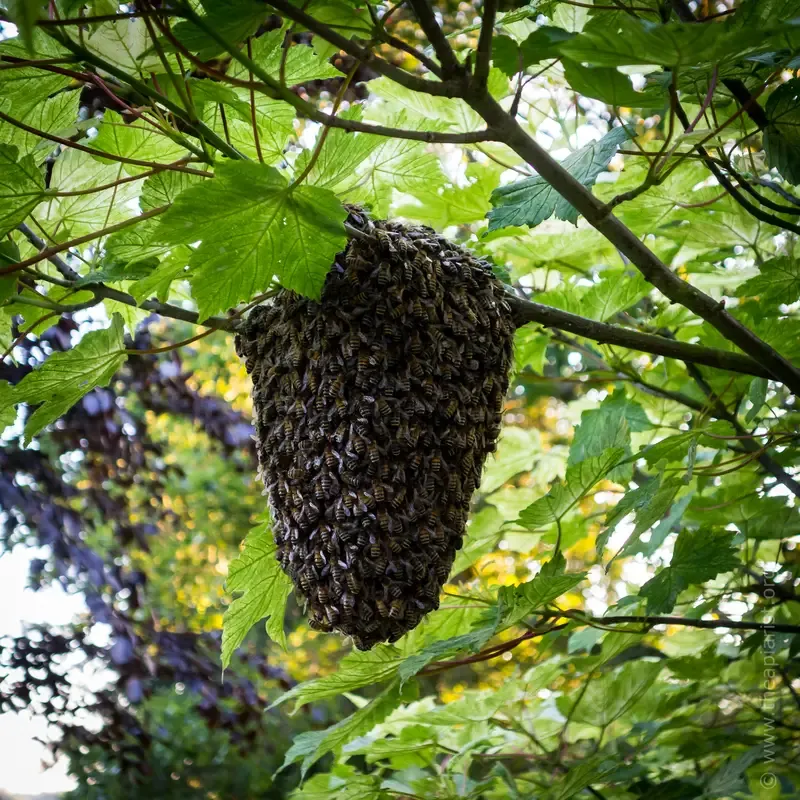
Of course, this doubling, trebling or quadrupling all depends upon the survival of the swarm and afterswarms ... but that's a separate issue from whether they are produced or not.
What determines whether afterswarms are produced?
It's years since I've knowingly lost an afterswarm from my colonies. I might lose the odd swarm or two (and don't believe a beekeeper who says they don't 😜) but, if I do, I promptly destroy all but one of the remaining queen cells, so ensuring that only a single virgin emerges.
I had always assumed that the more queen cells that were left, the greater the chance of losing an afterswarm.
However, an evening rummaging through the digital archive showed that I was wrong.
Forty five years ago Mark Winston was investigating the reproductive rate of unmanaged colonies in Kansas (Winston, 1980). The reproductive rate is the number of swarms or casts produced that could form new colonies (if they survived i.e. it's their production, rather than their survival). Similar studies had been done by Thomas Seeley in New York, an area with a much shorter season than Kansas.
Winston established five colonies and then recorded what happened. He did no swarm prevention or control, but did conduct inspections to score the strength of the colony, to count queen cells and to quantify the proportion of workers 'lost' in swarms {{4}}.
Most swarms that appeared were captured, weighed and rehoused in a distant apiary for a few weeks before being returned to the study apiary. These swarms were similarly observed. The swarm season in Kansas starts in late April, and early season swarms can grow and swarm again before the end of the season.
The numbers
Over the course of the experiment, the mean number of daughter queens produced per queen (the reproductive rate) was 3.6. These daughter queens were the ones that headed swarms or afterswarms. The original colonies, or the hived swarms that they produced, generated ~16 queen cells per colony (115 in total).
Over the year, an average of 1.5 afterswarms were produced per colony (actually 2 from colonies that initially swarmed, and 0.7 from those that swarmed again).
Prime swarms contained ~16,000 workers, significantly more than the first afterswarms which were about a third smaller at ~11,500 workers. Any subsequent afterswarms were smaller still, containing only ~3,700-4,300 workers.
Remember, Winston was measuring the reproductive rate ... in reality, the probability of these small second or third afterswarms surviving was limited.
But not zero.
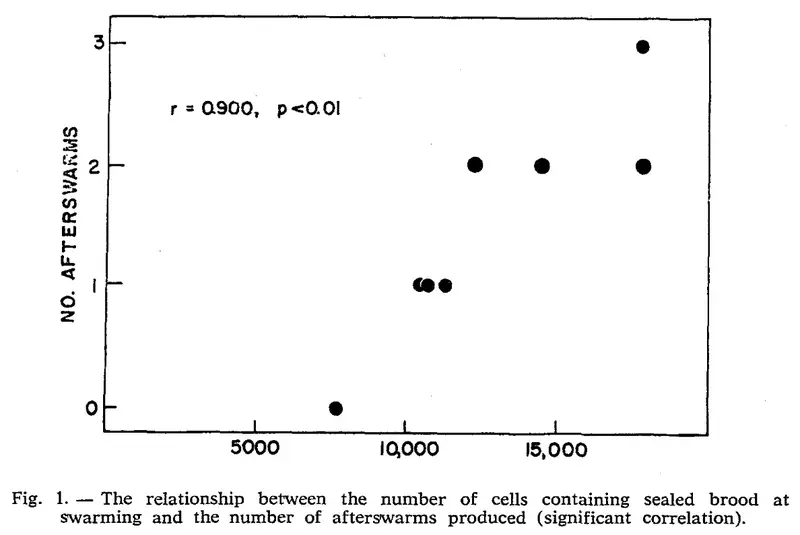
Importantly, and the answer to the question posed above - What determines whether afterswarms are produced? - is that it was not the number of queen cells, but it was the area of sealed brood remaining in the swarmed colony.
A colony that produced lots of queen cells, but had relatively little sealed brood, was unlikely to produce a cast swarm. In contrast, colonies with ~10,000+ sealed brood cells {{5}}, irrespective of the number of queen cells, produced at least one afterswarm.
For comparison purposes, ten thousand cells is (approximately) two National brood frames completely filled with sealed brood.
Caveats and qualifications
Things change during the season. It's possible that fewer afterswarms were produced from swarming colonies later in the season because of changes in the environment e.g. there is more limited forage in Kansas between late June to August than early or late in the season.
These things are nearly impossible to control in a field experiment like this one, so brood area may not be the only thing that determines afterswarm production.
It's worth making a final comment on the likely survival of swarms and afterswarms. Assuming they are, or end up, headed by a mated queen, their survival depends upon them occupying a suitable nest site, building sufficient comb, expanding the colony size and collecting enough stores to survive the winter. Obviously, the more workers present in the swarm, and the earlier in the season (within reason) that swarming occurs, the greater the chances of survival.
The survival of afterswarms, particularly second or third afterswarms, is hampered by their size and the age of the bees they contain. Most of the young bees leave with the prime swarm (the one containing the original mated queen), so the average age of bees in afterswarms will inevitably be older. Therefore, before the queen gets mated and starts laying, or before any of her brood emerges, a greater proportion of these workers may have died of old age ... so further limiting the chances of survival.
No risk, no reward
In Seeley's studies, swarm and afterswarm survival was ~25% and ~12% respectively, though I don't think he made the distinction between first, second or third afterswarms (as his colonies produced few of these).
So, why does the colony risk the likely failure of these second or third afterswarms (and possibly of the - now even weaker - original colony)?
Presumably because sometimes the gamble pays off ... some of these afterswarms survive, more of that particular genetic line (the one that produces multiple afterswarms) then gets the chance to reproduce again.
I hope my swarm control remains sufficiently robust that I don't lose too many swarms in the future ... I like my bees to remain my bees, so they can make honey and not irritate the neighbours by going into their chimney. However, if and when one does escape, I'll take a look at the number of queen cells and the sealed brood remaining as a guide to whether it would produce afterswarms.
But I'll still knock back all but one of the queen cells ... 😉.
Casts
I've used the term afterswarm in the paragraphs above because that's what Winston used in the title of his paper, and because it's a little more understandable.
However, I also looked up the etymology of the word cast.
Somewhere buried in my digital archive I've made a note that the term prime when applied to a swarm is an adjective that describes the type of swarm i.e. the first swarm to be produced. In contrast, cast is a verb, describing the action of casting - or throwing - bees out of the hive.
Is this correct, or might there be another definition?
I checked the Oxford English Dictionary and it didn't help much except it showed an alternative meaning of the word cast.
adj. chaste (derived from the Latin castus meaning morally pure)
This meaning is obsolete, its use being restricted to Middle English (1150-1500). However, it also makes some sense when you consider that cast swarms are headed by unmated, virgin queens.
Whether the weather is right for foraging
Two related (just about) topics to end on, both rediscovered recently.
"There's no such thing as bad weather, only unsuitable clothing"
Although first attributed to Alfred Wainwright this cliche is often repeated by manufacturers of GoreTex jackets. But just as hillwalkers might be put off by inclement weather, fishermen and beekeepers both use weather as an excuse for things not going right.
Too wet, too dry, too windy, too bright, too dull, too cold, too hot ... I could go on.
Honey bees don't have the benefit of GoreTex apparel, and although their waxy cuticle gives some protection from the wet, heavy rain largely restricts foraging activity (I'll return to rain at the end).
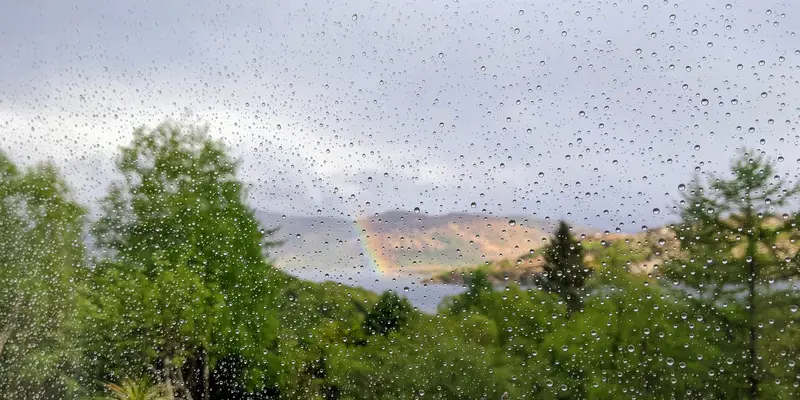
Beekeepers all know that calm, dry, settled, warm and sunny weather - together with abundant forage - results in heavy supers, but what are the primary determinants of foraging activity?
For example, what is the relative importance of sun when compared with warmth, or humidity, or whatever?
These factors influence both the ability of the bees to fly (too cold or too wet and they stay at home) and the forage availability in the environment.
The quantity and quality of nectar varies with the weather, both on the day and over a longer term. Through a feedback mechanism this will either encourage or discourage bees from foraging.
And, it's not just honey bees that are affected like this. Bumble bees preferentially collect pollen on dry, warm and windy days, but otherwise collect nectar.
Hive automation and prediction of foraging activity
Around the time that Mark Winston was studying the reproductive rate of honey bees in Kansas, Burrill and Dietz (1981) were looking at the impact of temperature and solar radiation on hive activity.
As the temperature increased the hives became more active (measured in terms of ingress/egress at the hive entrance).
"Tell me something I don't know", said beekeepers everywhere 😉.
Up to a point there was also an increase in hive activity as solar radiation increased, but this trend was reversed at high levels of solar radiation.
It's clear that individual bees can sense and respond to changes in environmental conditions, and make decisions about whether to venture out or not.
We can measure the weather reasonably accurately - temperature, pressure, humidity etc. - and, if needed, very frequently e.g. every minute. We also now have more accurate and automated methods for recording hive entrance activity.
With enough measurements of these sorts of things it should be possible to develop a model that predicts foraging activity.
Clarke and Robert (2018) published a small scale study in which they attempted to determine the primary weather factors that influenced foraging activity, and then used these in a model that predicted hive activity.
Formally they did not show that the bees leaving and entering the hive were actually collecting anything, but the study was conducted from June to September, so I think it's fair to assume that it was mainly forager activity that was being recorded at the hive entrance.
Cut to the chase
Clarke and Robert (2018) measured the weather parameters - temperature, solar radiation, atmospheric pressure, humidity, rainfall, wind direction and speed - together with the bee egress rate every minute between midsummer and September in two separate seasons.
They then analysed the data to determine which of the weather parameters, or combination thereof, best predicted hive activity.
Finally, they used the important measured weather conditions to predict hive activity (which was then overlaid) to determine how good the model was.
I'm not going to go through all the gory details ... the paper is Open Access and - if you appreciate ordinary-least-squares generalised linear models (!) - you can enjoy reading it with a cup of tea one cold, rainy, winter evening.
Almost 80% of foraging activity could be predicted solely from the temperature and solar radiation data.
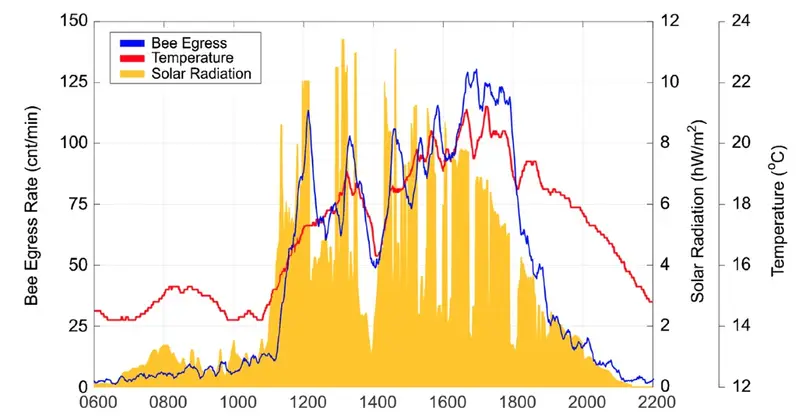
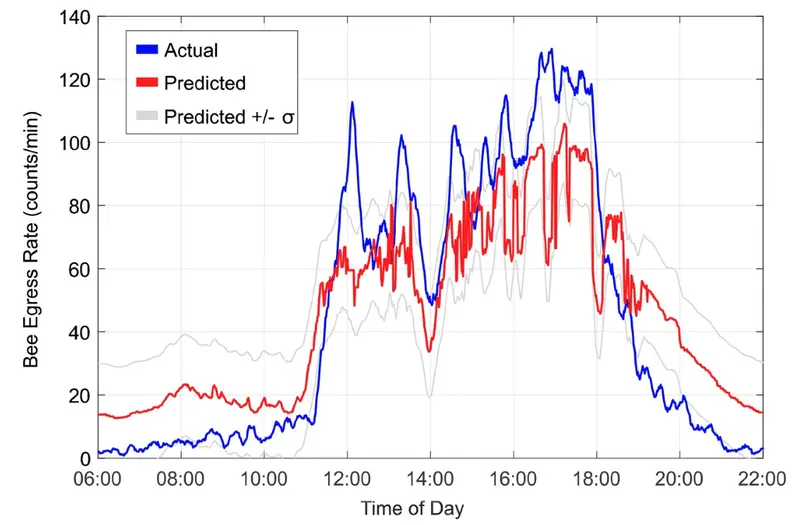
Real data (left) for activity, temperature and radiation, and model accuracy (right) showing actual and predicted activity (Clarke and Robert, 2018)
On the left is a typical day showing temperature in red, bee egress in blue and solar radiation in yellow. This was June the 7th, a day that started cloudy but became clear and sunny after 11 am.
On the right is the actual egress rate (in blue again) together with the rate predicted (in red) from the model they developed, based upon the solar radiation and temperature. Again, this is for June 7th.
As you can see, the blue and red lines, while not superimposed, are reasonably close. Bee activity is overestimated early and late in the day, and underestimated - perhaps by 20% or so - between 12.00 and 18.00.
Why might you want to know this?
Here are the actual (blue) and predicted (red) measurements of hive activity over several days not used to develop the model i.e. it's not a self-fulfilling prophesy, the observed measurements on these days did not contribute to model development. As before, the match is pretty good.
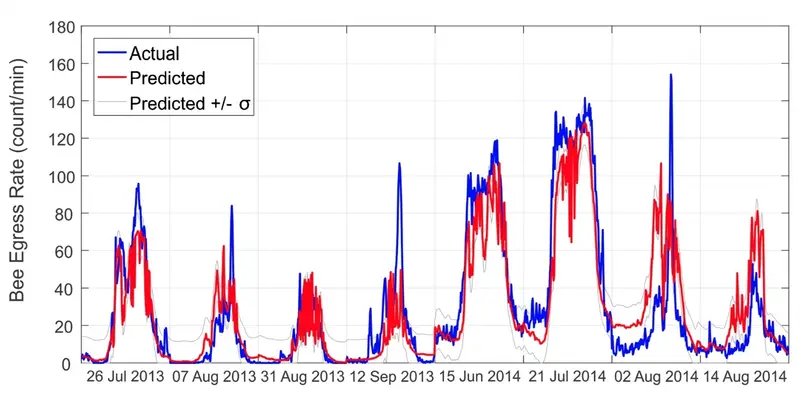
But, why might this be useful?
Surely you can just toddle down to the apiary and watch the bees?
Well, yes, we probably can, but if you're a commercial beekeeper running 1000 colonies several hundred miles away you need to be able to predict whether they're going to need additional supers, without having to make a return trip to collect those supers. Conversely, if the weather predicts little or no hive activity you might need to fill the van with fondant rather than empty supers.
Why might the model be wrong?
The statistician George E.P. Box famously said ...
All models are wrong, but some are useful
... meaning that they are a simplification of reality, but they may still have useful application.
Why might the model developed by Clarke and Robert (2018) be wrong?
By recording weather and activity minute by minute they determined the relationship between events occurring at the same time.
I've already described how prior weather conditions might influence foraging ... if there's been an extended drought, nectar production will be reduced and, as a consequence, the bees have less incentive to forage.
But it turns out that the future weather also influences foraging activity. This deserves a separate post altogether, but here's a teaser to whet your appetite.
There's an interesting letter to the editor of Insect Science by He et al., (2016) that shows that bees forage for longer, and until later in the day, on days that were followed by rain.
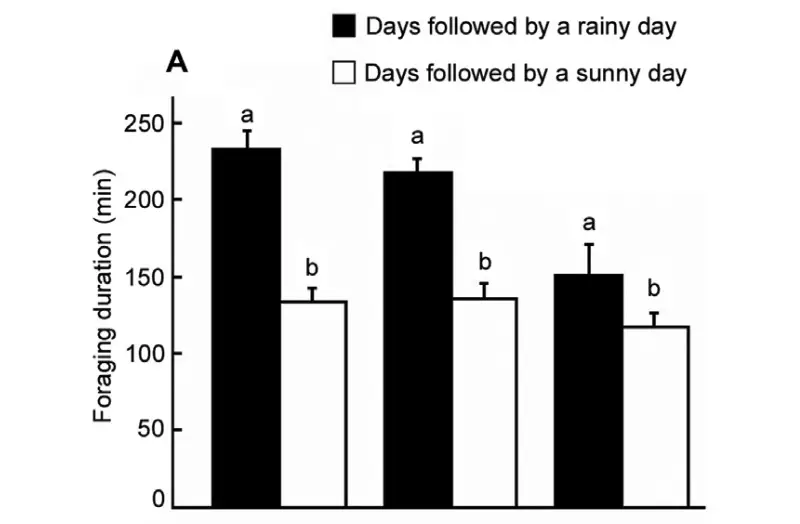
The differences were striking; on days preceding wet days the bees were active for 25-40% more of the day, and foraged later into the evening by 20-40 minutes. These measurements were based on individual RFID-marked bee activity though the resulting weights of pollen or nectar collected were not recorded.
Was the additional 'work' reflected in increased stores, or were they just working harder for the same reward?
Irrespective of the answer to that question, it's clear that predicting colony activity may also require understanding how the bees determine whether the following day (or days?) are going to be suitable for foraging.
In the meantime, with the weather here being an unwelcoming 1°C there's no chance of any bees venturing out of the hives, and more opportunities for me to rummage through the digital archive to rediscover other things I've forgotten. This is why I've appended a pseudo-scientific "part 1 of N" to the title of this post, where N is a number that has yet to be determined.
And might be ∞ 😄.
Sponsor The Apiarist
If you enjoyed this post, please consider becoming a sponsor of The Apiarist. Sponsorship costs less than a few sheets of foundation a month or £1/week annually. Sponsors help ensure the weekly posts appear, have access to an increasing number of sponsor-only content (those starred ⭐ in the lists of posts), and receive my undying gratitude. I know which of these I'd prefer.
Alternatively, you can help reduce my caffeine overdraft ... and please spread the word to encourage others to subscribe.
Thank you
Notes
∞ is the mathematical symbol for infinity.
References
Burrill, R.M., and Dietz, A. (1981) THE RESPONSE OF HONEY BEES TO VARIATIONS IN SOLAR RADIATION AND TEMPERATURE. Apidologie 12: 319–328 http://dx.doi.org/10.1051/apido:19810402.
Clarke, D., and Robert, D. (2018) Predictive modelling of honey bee foraging activity using local weather conditions. Apidologie 49: 386–396 https://doi.org/10.1007/s13592-018-0565-3.
He, X.-J., Tian, L.-Q., Wu, X.-B., and Zeng, Z.-J. (2016) RFID monitoring indicates honeybees work harder before a rainy day. Insect Science 23: 157–159 https://onlinelibrary.wiley.com/doi/abs/10.1111/1744-7917.12298.
Winston, M.L. (1980) Swarming, afterswarming, and reproductive rate of unmanaged honeybee colonies (Apis mellifera). Ins Soc 27: 391–398 https://doi.org/10.1007/BF02223731.
{{1}}: Standing on the shoulders of giants.
{{2}}: Obsidian is an outstanding note-taking/writing application, Wallabag is a read-later service that allows you to save articles and read them in the bath, or on a long-haul flight, and Zotero is a reference manager software for scientific papers. All are open source.
{{3}}: figurative. Used to indicate passage into a strange, surreal, or nonsensical situation or environment.
{{4}}: He did this in a clever way, by 'seeding' the colony with known numbers of marked workers ... the number remaining, after swarming, helped quantify the population size if the swarm was lost. If the swarm was recaptured the number of bees in it was determined by weighing them.
{{5}}: In this particular experiment, it could be different in another strain of bees, hive type or location.
Join the discussion ...